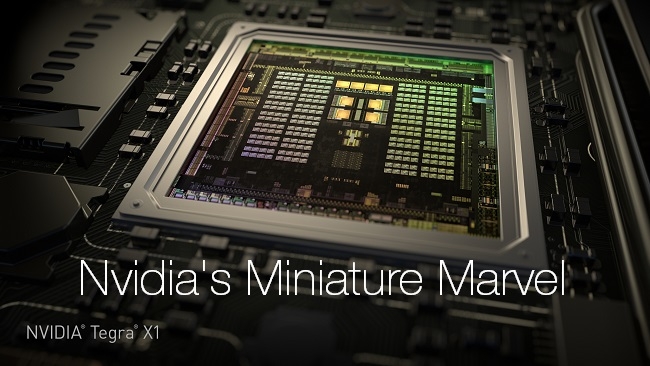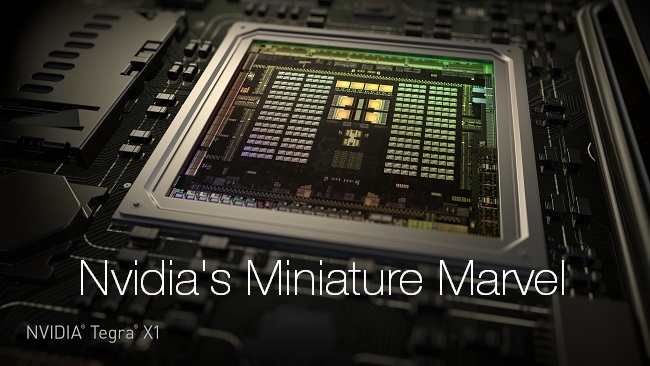
 Nvidia Tegra X1
Nvidia Tegra X1
Nvidia has a new mobile chip that's as powerful as the world's fastest supercomputer in the year 2000
Nvidia are well known for their high end PC graphics cards like the GTX series and Quadro, and they also make the chips that power some mobile devices. This year at CES they were showing off their latest mobile processor, the Tegra X1, which has one teraflop of computing power in a package the size of your thumbnail.
To put things in perspective, one teraflop was the speed of ASCI RED, the worlds fastest supercomputer from in the year 2000. Operated by the US Government department of Energy, ASCI RED occupied 1,600 square feet of space and used 500,000 watts of power. The Tegra X1 has the same computing power, but uses just 10 watts of power.
The Tegra X1 uses the latest Maxwell architecture from Nvidia. Twice as fast as last year's Kepler based Tegra K1, the X1 has a 256 core GPU and 2 quad core CPUs. It can handle 4K video playback at 60fps and supports all major graphics standards including Unreal Engine 4, DirectX 12, OpenGL 4.5, CUDA®, OpenGL ES 3.1 and the Android Extension Pack.
Nvidia demonstrated the X1 running the "Elemental" Unreal 4 engine demo. When that was first shown in 2012 it was pushing the boundaries of what a high end PC could do. The following year it was shown running on the Playstation 4 and now it is running on the Tegra X1. Apparently it took just over a week to get it to run in real time on the X1! Take a look at the video.
Nvidia's plans for the X1 are not just for Mobile devices and gaming consoles. It is also at the heart of their new automotive products, the Nvidia Drive PX and CX. Nvidia drive PX uses two Tegra X1 chips to analyse video from up to 16 cameras mounted on the car, making the car capable of self driving and self parking. Drive CX uses a single Tegra X1 to power multiple screens in a car, not only the dashboard displays but also the entertainment system, with different passengers able to view different content.
You can read more details in Nvidia's press releases after the break
NVIDIA has unveiled Tegra® X1, its next-generation mobile super chip with over one teraflops of processing power – delivering capabilities that open the door to unprecedented graphics and sophisticated deep learning and computer vision applications.
Tegra X1 is built on the same NVIDIA Maxwell™ GPU architecture rolled out only months ago for the world's top-performing gaming graphics card, the GeForce® GTX 980. The 256-core Tegra X1 provides twice the performance of its predecessor, the Tegra K1, which is based on the previous-generation Kepler™ architecture and debuted at last year's Consumer Electronics Show.
Tegra processors are built for embedded products, mobile devices, autonomous machines and automotive applications. Tegra X1 will begin appearing in the first half of the year.
It will be featured in the newly announced NVIDIA DRIVE™ car computers. DRIVE PX is an auto-pilot computing platform that can process video from up to 12 onboard cameras to run capabilities providing Surround-Vision, for a seamless 360-degree view around the car, and Auto-Valet, for true self-parking. DRIVE CX is a complete cockpit platform designed to power the advanced graphics required across the increasing number of screens used for digital clusters, infotainment, head-up displays, virtual mirrors and rear-seat entertainment.
"We see a future of autonomous cars, robots and drones that see and learn, with seeming intelligence that is hard to imagine," said Jen-Hsun Huang, CEO and co-founder, NVIDIA. "They will make possible safer driving, more secure cities and great conveniences for all of us.
"To achieve this dream, enormous advances in visual and parallel computing are required. The Tegra X1 mobile super chip, with its one teraflops of processing power, is a giant step into this revolution."
Driven by the exceptional graphics compute horsepower from Maxwell, NVIDIA's 10th-generation GPU architecture, Tegra X1 is the first mobile processor with capabilities that rival supercomputers and game consoles.
Faster Than Previous Top Supercomputer
Indeed, Tegra X1 has more horsepower than the fastest supercomputer of 15 years ago, ASCI Red, which was the world's first teraflops system. Operated for a decade by the U.S. Department of Energy's Sandia National Laboratory, ASCI Red occupied 1,600 square feet and consumed 500,000 watts of power -- with another 500,000 watts needed to cool the room it occupied. By comparison, Tegra X1 is the size of a thumbnail and draws under 10 watts of power.
As serious gamers know from using the NVIDIA® GeForce® GTX 980 GPU, the Maxwell architecture solves some of the most complex lighting and graphics challenges in visual computing. Its innovations include Voxel Global Illumination, or VXGI, for real-time dynamic global illumination and Multi-Frame Anti-Aliasing, or MFAA, for incredibly lifelike graphics in the most demanding games and apps.
"Tegra K1 set a new bar for GPU compute performance, and now just a year later Tegra X1 delivers twice that," said Linley Gwennap, founder and principal analyst of the Linley Group. "This impressive technical achievement benefits both 3D graphics, particularly on devices with high-resolution screens, as well as GPGPU software that is becoming more prevalent, particularly in automotive applications."
Technical Specifications
Tegra X1 supports all major graphics standards, including Unreal Engine 4, DirectX 12, OpenGL 4.5, CUDA®, OpenGL ES 3.1 and the Android Extension Pack, making it easier for developers to bring PC games to mobile.
Tegra X1's technical specifications include:
256-core Maxwell GPU
8 CPU cores (4x ARM Cortex A57 + 4x ARM Cortex A53)
60 fps 4K video (H.265, H.264, VP9)
1.3 gigapixel of camera throughput
20nm process
More details are available on the Tegra X1 website.
Powered by Tegra X1, DRIVE PX Auto-Pilot and DRIVE CX Cockpit Computers Deliver Computer Vision, Deep Learning, Unprecedented Graphics in Cars
Transporting the world closer to a future of auto-piloted cars that see and detect the world around them, NVIDIA today introduced NVIDIA DRIVE™ automotive computers – equipped with powerful capabilities for computer vision, deep learning and advanced cockpit visualization.
NVIDIA will offer two car computers: NVIDIA DRIVE PX, for developing auto-pilot capabilities, and NVIDIA DRIVE CX, for creating the most advanced digital cockpit systems. These automotive-grade in-vehicle computers are based on the same architecture used in today's most powerful supercomputers.
"Mobile supercomputing will be central to tomorrow's car," said Jen-Hsun Huang, CEO and co-founder, NVIDIA. "With vast arrays of cameras and displays, cars of the future will see and increasingly understand their surroundings. Whether finding their way back to you from a parking spot or using situational awareness to keep out of harm's way, future cars will do many amazing, seemingly intelligent things. Advances in computer vision, deep learning and graphics have finally put this dream within reach.
"NVIDIA DRIVE will accelerate the intelligent car revolution by putting the visual computing capabilities of supercomputers at the service of each driver."
NVIDIA DRIVE PX
The NVIDIA DRIVE PX auto-pilot development platform provides the technical foundation for cars with completely new features that draw heavily on recent developments in computer vision and deep learning.
DRIVE PX leverages the new NVIDIA® Tegra® X1 mobile super chip, which is built on NVIDIA's latest Maxwell™ GPU architecture and delivers over one teraflops of processing power, giving it more horsepower than the world's fastest supercomputer of 15 years ago. DRIVE PX, featuring two Tegra X1 super chips, has inputs for up to 12 high-resolution cameras, and can process up to 1.3 gigapixels per second.
Its computer vision capabilities can enable Auto-Valet, allowing a car to find a parking space and park itself, without human intervention. While current systems offer assisted parallel parking in a specific spot, NVIDIA DRIVE PX can allow a car to discover open spaces in a crowded parking garage, park autonomously and then later return to pick up its driver when summoned from a smartphone.
The deep learning capabilities of DRIVE PX enable a car to learn to differentiate various types of vehicles -- for example, discerning an ambulance from a delivery van, a police car from a regular sedan, or a parked car from one about to pull into traffic. As a result, a self-driving car can detect subtle details and react to the nuances of each situation, like a human driver.
NVIDIA DRIVE CX
The NVIDIA DRIVE CX cockpit computer is a complete solution with hardware and software to enable advanced graphics and computer vision for navigation, infotainment, digital instrument clusters and driver monitoring. It also enables Surround-Vision, which provides an undistorted top-down, 360-degree view of the car in real time -- solving the problem of blind spots -- and can completely replace a physical mirror with a digital smart mirror.
Available with either Tegra X1 or Tegra K1 processors, and complete road-tested software, the DRIVE CX can power up to 16.8 million pixels on multiple displays -- more than 10 times that of current model cars.
Positive Industry Support
Ricky Hudi, executive vice president of Electrical/Electronics Development at AUDI AG, said: "Audi and NVIDIA share a common belief that machine learning is a powerful enhancement to our zFAS Piloted Driving technology. Thus, Audi sees DRIVE PX as a crucial tool for further research and development."
Thilo Koslowski, vice president and distinguished analyst at Gartner, said: "The realization of smart automobiles requires high-performance processing solutions that enable sophisticated sensor fusion and innovative machine learning. This will create a new class of self-aware and ultimately self-driving vehicles that can assess, sense, understand and react to the state of their surroundings and occupants."
Availability
Both NVIDIA DRIVE PX and DRIVE CX platforms include a range of software application modules from NVIDIA or third-party solutions providers. The DRIVE PX auto-pilot development platform and DRIVE CX cockpit computer will be available in the second quarter of 2015.
Tags: Technology


Comments